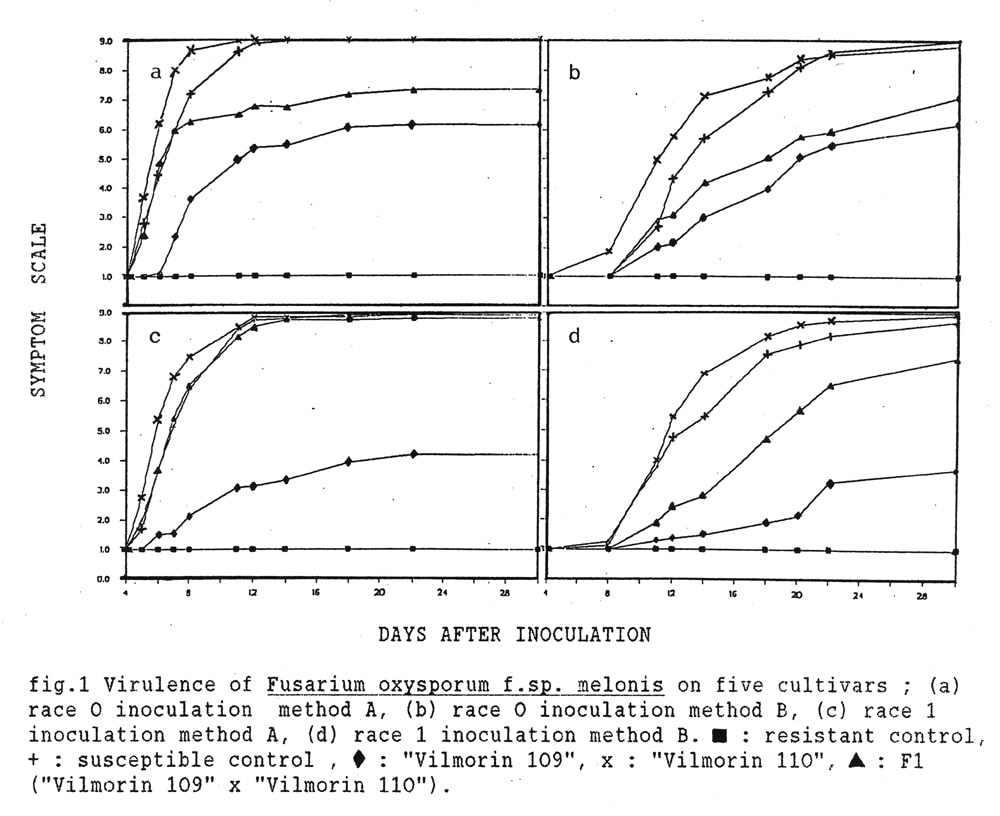Cucurbit Genetics Cooperative Report 12:37-38 (article 15) 1989
D. Gabillard and M. Jacquet
Institut de Recherches Vilmorin, Ledenon, 30210 Remoulins, France
Intermediate resistances have already been described with Fusarium oxysporum f. sp. melonis race 2. This study deals with a case of tolerance to races 0 and 1 found in a line ‘Vilmorin 109’.
The line ‘Vilmorin 109’ was crossed with a very susceptible (to race 0 and 1) netted line ‘Vilmorin 110’. None of both lines had gene (Fom-1) nor (Fom-2). Both can be considered homozygous (inbreeding for 9 generations).
Two types of inoculation were tested: A) plantlets were removed from seedling pots at the cotyledon stage; roots were pruned to about 20 mm and dipped for 1 mn in Fusarium suspension (105 conidia/ml). Then they were transplanted into growing trays and placed in a growth chamber (day/night, 24/18°C, 14/10 hours). B) 5 ml of the same suspension were poured at the basis of each plantlet at the cotyledon stage and placed in the same growth chamber.
Susceptible and resistant controls were respectively cv. Charentais T. and cv. Vedrantais for race 0 and cv. Vedrantais (Fom-1) and ‘Vilmorin 108’: (Fom-2) for race 1.
Virulence of both races was studied on the two parental lines an on the hybrid for one month. Two Fusarium oxysporum isolates of each race were also studied but they were not statistically different for their pathogenicity. The symptom scale is: (1) no symptom, (3) symptom of physiological disorders, (5) beginning of yellowing, (7) entire plantlet yellowing, (9) plantlet death (fig. 1a, b. c, d).
In every four experiments, ‘Vilmorin 109’ appeared statistically different from the susceptible and the resistant controls (see table 1). On the other hand the symptoms became visible faster on ‘Vilmorin 110’ than on the two controls. The level of the F1 (‘Vilmorin 109’ x ‘Vilmorin 110’) was between the level of the two parents indicating a partially dominant gene action. This intermediate level, obvious with race 0, was impossible to detect with the race 1 and method A (fig. 1c) but could be seen with method B (fig. 1d). This agreed with the work of Latin and Snell (1) and emphasized that different results could be obtained with different inoculation methods.
In the case of emergence of a new race of Fusarium or the spreading out of the race 1, 2, these “minor” genes, beside the 2 genes (Fom-1) and (Fom-2), will perhaps play a prominent part in muskmelon breeding programs.
Figure 1. Virulence of Fusarium oxysporum f. sp. melonis on five cultivars; (a) race 0 inoculation method A, (b) race 0 inoculation method B, (c) race 1 inoculation method A, (d) race 1 inoculation method B.

Table 1. Newmann-Keuls test on symptom scale (P = 0.05).
Days after inoculation |
||||
6 8 14 |
11 14 22 |
6 8 14 |
11 14 22 |
|
Cultivars |
fig. 1A |
fig. 1b |
fig. 1c |
fig. 1d |
| ‘Vilmorin 110’ | A A A | A A A | A A A | A A A |
| Susc. Control | B B A | B AB A | AB A A | A B A |
| Fl (109 x 110) | B B B | B BC B | AB A A | B C B |
| ‘Vilmorin 109’ | C C C | B C B | BC B B | B D C |
| Resis. control | C D D | B D B | D B C | B D D |
Literature Cited
- Latin, R. X. and S. J. Snell 1986. Comparison of methods for inoculation with Fusarium oxysporum f. sp. melonis. Plant Disease 70:297-300.
- Zink, F.W., W.D. Gubler, G.R. Grogan. 1983. Reaction of muskmelon germ plasm to inoculation with Fusarium oxysporum f. sp melonis race 2. Plant Disease 67 : 1251-1255.